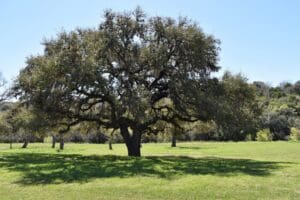
When selecting a tree for your home, there are three general sets of considerations:
- your goals
- the physical characteristics of various tree species
- the physical characteristics of your lot
Trees often enhance the appearance and value of our homes. At the same time, by proving shade, they can reduce air conditioning costs, reduce water needs for yards, and enable us to landscape with plants that can not tolerate full sun. At the same time, trees require care, which costs money.
Tree Maintenance Considerations
Maintenance items related to trees include but are not limited to: leaf removal, cleaning gutters, roof cleaning, watering, fertilizing, pool maintenance, and trimming. To select the optimal tree for your home, you need to balance the benefits and the costs.
Factors to Consider When Selecting Trees
Some common factors to consider when selecting the species of tree that you want are:
Curb Appeal: Adding trees can increase the value of a home. Larger trees, which need years to grow, often add the most value. If you plan to stay in your home for many years, think about the shape that you want. Do you want a tree that is tall and thin, such as an Italian Cypress (Cupressus sempervirens) or do you want a large tree with a spreading canopy, such as a Texas Live Oak (Quercus Fusiformis). When thinking about the shape that you want, do not forget to consider how long it will take for a tree to reach the size that you have in mind.
Shade: When adding a tree for shade, the growth rate is a major factor. Slower-growing trees, such as most species of oak (genus Quercus), can be beautiful with wide canopies and graceful branches. Unfortunately, because of their slow growth rates, you might need to wait 20 to 60 years before you the shade that you are looking for.
Maintenance: Trees require maintenance. They need to be trimmed to maintain an attractive shape, they need to be trimmed to keep them off of roofs, there are leaves and branches to be picked up, and they need to be fertilized and watered.
Foundations: Except in rare cases, trees do not lift up houses. Trees can easily lift sidewalks, patios, driveways, and any number of light structures or objects. Houses with slab foundations are generally too heavy to be lifted by trees. What trees can do is remove water from expansive soils causing such soils to shrink. Shrinking soils can mean settling homes.

There are some commonsense rules that can be applied. The bigger a tree is, or is likely to become, the bigger its root system will be. As trees get larger, they need more water. Trees that grow on the edges of wet environments (such as rivers, lakes, ponds and, swamps) need more water than trees that grow in drier places. The literature seems to indicate that the roots of a tree will generally radiate out from the trunk for a distance equal to the height of a tree. Of course, this likely varies considerably by species. As a practical matter, for most town lots, this means that the roots of any medium- to large-sized tree are likely to extend from the trunk of said tree to your foundation.
When considering trees and your foundation, the overwhelmingly important factor is the amount of water a tree needs. As trees dry out the soil under and around them, they cause water in adjacent soils to move towards their root systems. If your home is next to trees, the roots of nearby trees do not need to grow under your foundation to dry out the soils. By drying out the soils in your yard, a tree can cause water in the soils under your home to be drawn out towards the tree.
There are three basic strategies for dealing with large trees that are affecting or may affect your foundation. The first and most brutal is to remove a tree. Second, it is possible to alter the locations of a tree’s roots by watering, fertilizing, and root pruning. The third option, which can act as a form of root pruning, is to install root barriers.
If you have large trees on your lot and think you might need a root barrier, call Advanced Foundation Repair before the hot dry summer comes.

